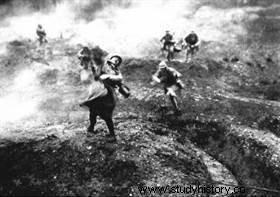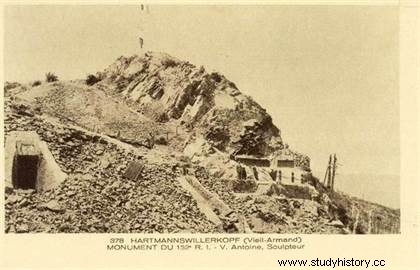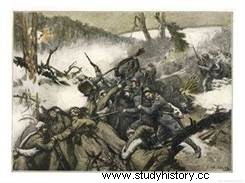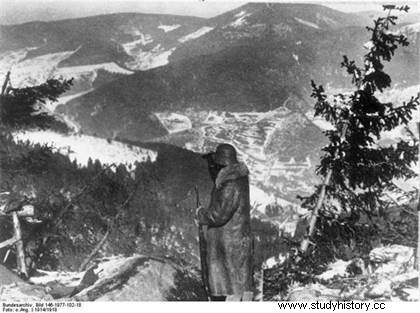 Obscured by the names of great battles from 14-18 such as Verdun, Champagne or Artois, Vieil-Armand or Hartmannswillerkopf remains largely unknown, although the intensity of the fighting that took place there made it one of the deadliest battlefields of the war, given the smallness of the terrain. Aspirant Martin, a soldier who served at the Hartmannswillerkopf, wrote in particular in a testimony:"I have never seen such a mass grave and during the following years I will not see, even in Verdun, such a pile of corpses in a field so chaotic on such a small space .
Obscured by the names of great battles from 14-18 such as Verdun, Champagne or Artois, Vieil-Armand or Hartmannswillerkopf remains largely unknown, although the intensity of the fighting that took place there made it one of the deadliest battlefields of the war, given the smallness of the terrain. Aspirant Martin, a soldier who served at the Hartmannswillerkopf, wrote in particular in a testimony:"I have never seen such a mass grave and during the following years I will not see, even in Verdun, such a pile of corpses in a field so chaotic on such a small space .
The Hartmannswillerkopf in 1914, a peaceful hill
Le Vieil-Armand is perched on the heights of Cernay (68) and culminates at 956 m. Last buttress of the Vosges, it dominates the plain of Alsace. Several explanations are possible to explain its name. First of all, “Hartmannswillerkopf”, named after the village of Hartmannswiller at the foot of the hill. He was nicknamed Vieil-Armand by the French during the Great War but also "the man-eater" (or "the man-eater", designating the hill), "the world's breaking machine", the "mount of death” or more simply the “HWK” or “HK”. So many emblematic nicknames that bear witness to the fierce fighting that took place on this hill as well as the abnegation of the soldiers who were the first actors, but above all the first victims.
Before the fighting, the HK is a peaceful summit, covered by a thick almost virgin forest, only a few hunter trails testify to the human presence. The hill is located between the valleys of the Thur and the Lauch, between the towns of Thann and Guebwiller. Two major ridges descend towards the plain, from northeast to southeast, called "thighs", left or right, by the soldiers. For the French, the HK is the best possible observatory with a breathtaking view of the plain of Alsace. For the Germans, this is the obligatory passage through which they hope to retake the Thur valley via the crests of the Vosges.
In addition, the HK site meets the criteria of the French tactics of "maneuver from above" which provides for excessive offensives in order to control the peaks in order to the domination of the plain of Alsace. This explains the weakness of French facilities:light and not made to last. Today there is almost nothing left of the French positions in the Vosges. The Germans prefer to settle for a long war. They use infantry economy tactics. That is to say that from the winter of 1914-1915 they were building, digging galleries, stretching cable cars, laying out roads, implementing special units of pioneers and miners, installing running water, electricity and telephone.
Thus, this meticulous work of defense makes the battlefields of the Vosges formidable defensive bastions, quasi-autonomous fortresses designed for a staged defense of the Alsatian hinterland. The economy is there, with minimum troops and maximum fortifications, they fix significant enemy forces that could be useful elsewhere. The Linge and the Reichackerkopf are dominated by the Germans, unlike the Hartmannswillerkopf or the Hilsenfirst which are dominated by the Alpines.
 It should be remembered that Alsace has been taken from the war since 1871 and now belongs to the German Reich. It is considered as a glacis to protect the empire against a French invasion. Thus, the density of the troops present on the spot is four times greater than the average for the whole of Germany. The French, for their part, never admire the loss of Alsace-Lorraine. They therefore fortified the eastern border between Belfort and Verdun, to concentrate most of their forces there for an upcoming revenge.
It should be remembered that Alsace has been taken from the war since 1871 and now belongs to the German Reich. It is considered as a glacis to protect the empire against a French invasion. Thus, the density of the troops present on the spot is four times greater than the average for the whole of Germany. The French, for their part, never admire the loss of Alsace-Lorraine. They therefore fortified the eastern border between Belfort and Verdun, to concentrate most of their forces there for an upcoming revenge.
The First World War was wanted by everyone and everyone had invasion plans in their "drawers". Joffre, for example, commander-in-chief of the French army, planned an offensive plan in the direction of Saarbrücken to break through in the direction of central Germany. The Schlieffen-Moltke plan, meanwhile, planned to go through Belgium to outflank the French army and annihilate it.
In Alsace, there are a hundred French units mainly made up of reservists and territorials (soldiers over the age of thirty-four, they are posted in quiet areas ) against two hundred Germans. General Serret commands the 66th Infantry Division (which includes the 152nd Infantry, which we will discuss later) and was replaced by General Nollet when he was killed in 1916. Opposite, the Germans are commanded by General von Lochow .
The Alsace Offensives (1914)
General Bonneau, commander of the 7th corps, fought for Mulhouse and Thann from August 7, 1914. The fighting took place in the Haut-Rhin and mainly around Mulhouse . The front stabilized fairly quickly and Joffre created the Army of Alsace on August 11 and placed it under the command of General Pau. The offensive resumed and on the evening of August 19 the French entered Mulhouse. On the 25th, the French troops evacuated Mulhouse as well as almost all of Haute-Alsace.
On the 28th, the Army of Alsace was officially dissolved to form the Vosges group, the tactics changed and the front was moved from the plain to the Vosges mountains. The fighting continued from time to time in the villages of the Doller valley, as was the case in Steinbach, the scene of very violent fighting, where there was house-to-house fighting.
Hartmannswillerkopf, the man-eater
Until the end of 1914 neither of the two opponents was interested in the Hartmannswillerkopf, the hill was ignored and devoid of a garrison. On December 22 of the same year, a company of the 68th B.C.A. sends 28 men to the top. The Germans set up a detachment of 43 men on December 28. The adversaries are unaware of their mutual presence, yet separated by a few hundred meters. On December 29, the Hartmann was occupied by the Alpine Chasseurs. Hostilities began on December 30 after the death of the first HK soldier, the German Ott of the 123rd L.I.R. during a skirmish in the forest. From this date, the fighting is engaged only between patrols and it will be necessary to wait for the beginning of the new year to see more important offensives and a reversal of strategy on the part of the high commands.
Thus, the fights of Hartmann took place mainly in 1915. The offensives and counter-offensives follow one another by period and the real planned offensives took place in January, March, April, September and December.
 As of January 4, the Germans brought up increasingly large numbers and attacked incessantly to dislodge the handle of hunters who counter them at the top. On January 21 the Germans seized the summit after heavy fighting. On March 26, the summit was taken by the 152nd R.I., the 7th and the 53rd B.C.A.
As of January 4, the Germans brought up increasingly large numbers and attacked incessantly to dislodge the handle of hunters who counter them at the top. On January 21 the Germans seized the summit after heavy fighting. On March 26, the summit was taken by the 152nd R.I., the 7th and the 53rd B.C.A.
On April 25, a German counter-attack reoccupied the summit and the ground lost in the previous months. Two battalions of the 152nd were wiped out. However, a French counter-attack made it possible to retake the summit the next day at 6 p.m., but it was abandoned because it was considered too exposed. The front then stabilized and a lull ensued which lasted all summer, barely disturbed by a few shells. The Germans took advantage of this to carry out major fortification and trench construction works.
Conversely, the French do their development work according to the poor geography and with the "means at hand". However, they are ingenious and take advantage of this to dig saps. To counter them and clear threatening trenches, the Germans are planning a flamethrower assault for September 9.
It was around the first decade of September that the new weapons of war appeared in Vieil-Armand, namely flamethrowers and gas shells.
In October 1915, after a draw, Dubail (commander of the 1st French army) instructed Joffre to "expand the still very precarious position of the Hartmannswillerkopf and to sit firmly to definitely avoid ebb and flow movements. The operation would not be very costly and would significantly promote the outlet in the plain of Alsace. Unfortunately, he was seriously mistaken.
The drama of Vieil-Armand:the attack of December 21, 1915
The French attack of December 21, 1915 was the largest of the entire war at Hartmannswillerkopf. It committed sixteen battalions and 239 pieces of artillery, i.e. one cannon for 13 meters of German trench! The guns thundered for five hours and sent more than fifty thousand shells on the opposing positions.
All German communications were destroyed. The Germans then engaged all their available troops in the battle and no longer had any reserve elements for the rest. They were quickly overwhelmed and their losses were considerable. Thousands of corpses from both sides then strewn the battlefield, the French took 1,358 prisoners of war, including 26 officers.
However, it was a well-conducted but poorly exploited assault and the French fell victim to their own victories, as reinforcements were not sent to the 152nd Infantry in time to hold a front of more than 5 km² after a breakthrough of more than 400 meters ahead. Unaware of the crucial fact that a final push, still achievable, would complete the dislocation of the enemy's position and would make it possible to push in the direction of Wattwiller, the French dug in and organized themselves for the next day to ensure liaison with the rear, but it's already too late.
Indeed, the Germans dug in and counter-attacked immediately because they had detected the preparations for the assault earlier thanks to a French deserter who warned of an attack from great style for the days ahead.
On the other hand, the French, exhausted by the fights of the day before, were caught in a pincer movement between the troops holed up in the underground passages dug during the summer which they submerged during of the assault without exploring them and the soldiers freshly arrived from Colmar and Mulhouse the next day (December 22). The fighting is furious, we fight hand-to-hand, but the French are overwhelmed and 152ème R.I. is annihilated.
On December 28, 1915, a new French assault was ordered. They make a big breakthrough but General Serret, commander of the 66th Infantry Division, falls in battle (wounded, he will die in Moosch hospital a few days later) and is replaced by General Nollet.
On January 7, 1916, the French command began to reflect on the strategy to adopt at the Hartmann because the attacks were costly and useless and the human resources were not inexhaustible. In addition, since December, we have also been thinking about a general offensive on the western front, in the north of France...
January 9, 1916, it was all over. The promising gains of December 21, 1915 are canceled and the French find themselves in their starting positions. General Dubail then declared to Joffre:"it is therefore important to close operations in the Hartmannswillerkopf region as soon as possible by carrying out the essential relief for the rest of the troops, but carefully avoiding letting them rush into the Vosges new divisions that it is only too obvious that we will ask you”.
In short, the Hartmannswillerkopf is "over".
The mountain calms down, interspersed with bloody blows of hands or artillery duels and is crisscrossed by incessant patrols, the summit is shared between opponents facing each other twenty meters sometimes.
Rest at the top? Major development works in the summer of 1915
 As we have seen previously, the period of calm from April to September 1915 is taken advantage of by the two adversaries to adjust the positions and fortify the acquired ground.
As we have seen previously, the period of calm from April to September 1915 is taken advantage of by the two adversaries to adjust the positions and fortify the acquired ground.
The Germans entrenched themselves durably in largely concrete fortified positions and set up the most efficient "comfort" installations. This is how they bring water and electricity to the front line. The electricity is used, among other things, to power the electric drills to dig the rock and the left thigh is practically fortified with special attention to the Bischofshut which will become an almost impregnable bastion.
They ascend hundreds of tons of cement by cable car and the men are carried up a stone staircase of 560 steps from the valley, called "Himmelsleiter" or "heavenly ladder"
The French, for their part, entrenched themselves as far as possible, despite the poor geographical situation. They build shelters with the logs of uprooted trees and increase the size of the parapets with sandbags and materials recovered after the bombardments. Nevertheless, even if the majority of the development work is less successful than that of the Germans, they also have some solidly fortified and concreted positions, such as the Sermet and Megard rocks. They also take advantage of the human and material resources of the Place d'Epinal and the forts of Haute-Meurthe.
Resupply was mainly done by mule backs and by team of oxen even if there is mention in some works of two tractors requisitioned in Tunisia! Transport is therefore extremely slow and quantities are limited, but the French are developing an important communication system and their artillery system is complete. Batteries are installed at the Molkenrain and the Grand Ballon to bombard the Hartmann.
1916-1918:trench warfare
After January 10, 1916, Vieil-Armand became a quiet area where no major action was taken until the end of the war, except for a few helping hands . The hill has already captured ten thousand French and twelve thousand Germans without either of the two adversaries gaining any advantage.
In the impossibility, due to the other offensives which are being prepared elsewhere in Alsace, of providing the means in men and artillery necessary for a continuation of the operations offensives on the HK, General Maud'huy, commander of the Eighth Army, ordered to organize on the spot and to give up mounting new counter-attacks. From this moment the front stabilizes on either side of this disputed summit which, after having cost so many human lives, becomes a no man's land between opposing positions often only a few meters apart.
As everywhere on the western front where positional warfare rules the battlefields, the men are suffering and the living conditions are deplorable. They suffered from hunger and vermin, but perhaps even more from the cold in winter when the hill was swept by gusts of wind which "pierced" the men, especially since in the winter of 1914-1915 they are not yet well equipped and coats and shoes against the great cold are lacking. On the other hand, the transport of weapons and ammunition on steep and icy paths often led to bad falls and broken bones.
The Germans had the advantage of being located to the south of the hill in concrete and dry positions unlike the French, as we have seen, who were exposed to the north and in makeshift shelters.
In addition, the soldiers suffered the trauma of the German Minnenwerfer, these weapons invented after the Russo-Japanese war in 1905 and which the Germans had manufactured by the S.A.C.M. (today ALSTOM) in Mulhouse. The projectiles, called “coal seals” by the French and launched by the “Erdmöser” (buried mortars) were of all calibers. Buried in the trench, they could shoot almost vertically to reach enemy positions just a few tens of meters away.
Thus, from 1916 to 1918, the sector was rather calm, apart from a few “marmitages” and skirmishes between patrols. The Hartmannswillerkopf becomes a "calm sector of the front", relegated to the background by the Verdun operations which will mark the beginning of the year 1916.
Some large-scale patrols with intensive bombardment of the lines were carried out, including the Rumänien operation of January 1917, during which the Ziegelrücken gallery disaster took place. Indeed, this gallery served as a shelter for the men who were preparing to attack, except that a too short blow from a minnenwerfer exploded near the entrance and caused a landslide that buried 65 of the 85 occupants. Gallieni, who became Minister of War, even wrote in January 1916 "necessity to put an end to isolated operations of the kind of Hartmannswillerkopf and to spare the lives of men".
Victory and the future of Hartmannswillerkopf
In early November 1918, rumors became clearer that the war was about to end and the German troops transported from Russia after the armistice showed some signs of rebellion. On November 4, the Hartmann made its last victim, it was a German soldier named Weckerle who fell at the head of his patrol. On November 9, the L.I.R. 124 is about to unleash a coup de main but the French come out of the shelters and shout “The war is over! Peace ! And the German command immediately canceled the operation.
On November 10, for the first time in four years, no shots were fired at the mountain. At 11 a.m. on November 11, artillery salvos and gunfire rang out to hail the end of the war, and soldiers from both sides who had fought relentlessly for four years emerged from the trenches, shook hands, offer drinks, have the shelters visited... On November 15, the Germans left the Hartmannswillerkopf for good.
The site was abandoned until 1921 when it was classified. It was thus decided to build the national monument. Moreover, the site avoids the decree of 1923 which prescribes the reforestation of "red zones" as was the case of Verdun where the battlefield has completely disappeared today.
In 1945, Gauleiter Wagner ordered the building to be blown up, but nothing happened. However, during the Second World War, the bones from the crypt were moved and buried in mass graves in the villages of the valley and the land was used as a parade ground for Wehrmacht troops.
Were the battles of Vieil-Armand useless? Did they fight for honor? These questions are worth asking. As we have seen, the incessant struggle, the long battles, the massive bombardments have not overcome either of the two adversaries. The offensives and counter-offensives succeeded each other without result. A gain in ground one day is lost the next. In addition, the losses are substantially the same for everyone. The French lost about 14,500 men against 12,500 for the Germans.
The Hartmannswillerkopf fights were not in fact a one-off phenomenon but resulted from the manifestation of operative reflections and larger planning of the staffs. Indeed, the German command hesitated between Verdun and Belfort to lead the general offensive of 1916 but the Belfort gap represented far too many risks and Verdun was chosen because if Belfort was entirely in French hands, the HK posed a double threat. on the right wing of the German attacking forces by the possibility of flanking them or taking them from behind.
For the French general staff, the Hartmann represented the pillar of an offensive from Belfort towards Haute-Alsace. The direction is reversed but the problem remains the same, the HK would thus threaten the left flank of the French forces if it was not conquered. The battles of 1915 were therefore not fought for honor and to regain lost ground, but they fit well within the much broader framework of the tactics and offensives of the First World War.
Almost intact, the site of the Vieil Armand battlefield is easily visited.
To go further
- General de Pouydraguin, The Battle of the Hautes-Vosges, Payot, 1937
- Thierry Ehret, 1914-1918, around the Hartmannswillerkopf, Éditions du Rhin, 1988
- A. Wirth, Les Combats Du Hartmannswillerkopf (Vieil-Armand) 1914-1918, Hartmannswillerkopf National Monument Committee, 1977.
- Jean-Paul Claudel, The Battle of the Borders, Vosges 1914-1915, The Blue Cloud, Strasbourg, 1999.
